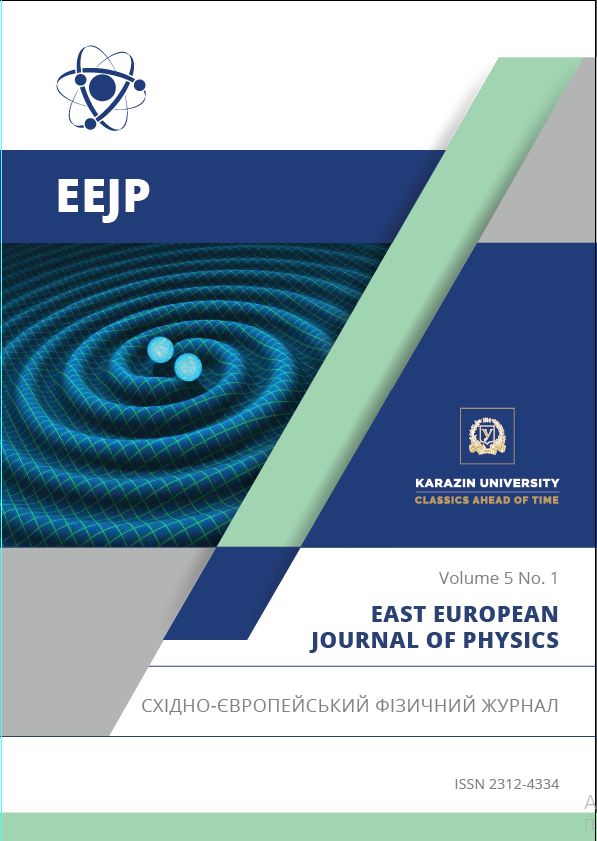MODEL OF A DIPOLE WITH ATOMIC STRUCTURE
Abstract
In this paper, we propose a model of a dipole with an atomic structure instead of the standard dipole model with point unlike charges and the Hertzian dipole model, which have significant drawbacks. The equations of the Hertzian dipole and the standard model operate from a distance much larger than size of the dipole, and the quasistatic Coulomb and Biot-Savart fields are the essence of the reactive near field, its own fields with a phase shift ΔφE,H = π/2, which have no restrictions on the distances to a dipole, since they are directly related to charges and their motion – currents. In the framework of the proposed dipole model, we described the physical mechanisms for the formation of near and far fields of an oscillating dipole, which are based on the use of the Coulomb and Biot-Savart fields, the quasistatic lines of force of their electric charge fields Е, and the magnetic fields of the currents Н for the analysis of energy fluxes: reactive Sr at ΔφE,H = π/2 and active Sа at ΔφE,H = 0 alike.
Downloads
References
2. Sydorenko V.S., Gayday Y.O., Zhyla S.V. Peculiarity of near-field of Hertz dipole // Bullet. Univ. Kiev. Ser.: Phys. & Math. – 2005. – Iss. 2. – P. 365–372. (in Ukrainian)
3. McDonald K.T. Radiation in the Near Zone of a Hertzian Dipole [Electronic resource] // Joseph Henry Laboratories, Princeton University. – 2004. – URL: http://www.physics.princeton.edu/~mcdonald/examples/nearzone.pdf
4. McDonald K.T. Flow of Energy and Momentum in the Near Zone of a Hertzian Dipole [Electronic resource] // Joseph Henry Laboratories, Princeton University. – 2014. – URL:
http://www.physics.princeton.edu/~mcdonald/examples/hertzian_momentum.pdf
5. Staliunas K., Markoš P., Kuzmiak V. Scattering properties of a PT dipole // Phys. Rev. A. – 2017. – Vol. 96. –Iss. 4. – P. 043852.
6. Wong H.M.K., Dezfouli M.K., Axelrod S., Hughes S., Helmy A.S. Theory of hyperbolic stratified nanostructures for surface enhanced Raman scattering // Phys. Rev. B. – 2017. – Vol. 96. – P. 205112.
7. Cao D., Cazé A., Calabrese M., Pierrat R., Bardou N., Collin S., Carminati R., Krachmalnicoff V., De Wilde Y. Mapping the radiative and the apparent non-radiative local density of states in the near field of a metallic nanoantenna // ACS Photonics. –
2015. – Vol. 2. – Iss. 2. – P. 189–193.
8. Boutelle R.C., Yi X., Neuhauser D., Weiss S. SOFI for Plasmonics: Extracting Near-field Intensity in the Far-Field at High Density // ACS Nano. – 2016. – Vol. 10. – Iss. 8. – P. 7955–7962.
9. Landau L.D., Lifshitz E.M. Course of Theoretical Physics. Vol. 2: The Classical Theory of Fields (8th ed.). – Moscow: Fizmatlit, 2012. – 536 p. (in Russian)
10. Kuznetsov S.I. Oscillations and waves. Geometric and wave optics (2nd ed.). – Tomsk: TPU, 2007. – 170 p. (in Russian)
11. Stas D.V., Plyusnin V.F. Quantum Mechanics of Molecules. Part 1: Atom. – Novosibirsk: NSU, 2008. – 186 p. (in Russian)
Authors who publish with this journal agree to the following terms:
- Authors retain copyright and grant the journal right of first publication with the work simultaneously licensed under a Creative Commons Attribution License that allows others to share the work with an acknowledgment of the work's authorship and initial publication in this journal.
- Authors are able to enter into separate, additional contractual arrangements for the non-exclusive distribution of the journal's published version of the work (e.g., post it to an institutional repository or publish it in a book), with an acknowledgment of its initial publication in this journal.
- Authors are permitted and encouraged to post their work online (e.g., in institutional repositories or on their website) prior to and during the submission process, as it can lead to productive exchanges, as well as earlier and greater citation of published work (See The Effect of Open Access).








